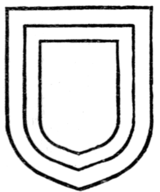"impalement," in which the entire designs of both coats of arms are depicted. But in impaling a coat of arms which is surrounded by a bordure, the bordure is not continued down the centre between the two coats, but stops short top and bottom at the palar line. The same rule, by the way, applies to the tressure, but not to the orle. The curious fact, however, remains that this rule as to the dimidiation of the bordure in cases of impalement is often found to have been ignored in ancient seals and other examples. The charges upon the bordure are often three, but more usually eight in number, in the latter case being arranged three along the top of the shield, one at the base point, and two on either side. The number should, however, always be specified, unless (as in a bordure bezantée, &c.) it is immaterial; in which case the number eight must be exceeded in emblazoning the shield. The rule as to colour upon colour does not hold and seems often to be ignored in the cases of bordures, noticeably when these occur as marks of Scottish cadency.
THE ORLE
The orle (Fig. 226), or, as it was originally termed in ancient British rolls of arms, "un faux ecusson," is a narrow bordure following the exact outline of the shield, but within it, showing the field (for at least the width usually occupied by a bordure) between the outer edge of the orle and the edge of the escutcheon. An orle is about half the width of a bordure, rather less than more, but the proportion is never very exactly maintained. The difference may be noted between this figure and the next (Fig. 227), which shows an inescutcheon within a bordure.
 Fig. 226.—Orle. |
 Fig. 227.—An inescutcheon within a bordure. |
Though both forms are very seldom so met with, an orle may be subject to the usual lines of partition, and may also be charged. Examples of both these variations are met with in the arms of Yeatman-Biggs, and the arms of Gladstone afford an instance of an orle "flory." The arms of Knox, Earl of Ranfurly, are: Gules, a falcon volant or, within an orle wavy on the outer and engrailed on the inner edge argent.
When a series of charges are placed round the edges of the
